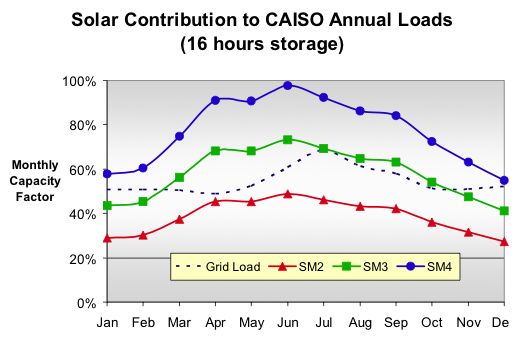Ausra’s Bold Claim
We’ve been tracking solar thermal for some time as it is intended to be part of our Sou Hills project in due course. One of the more interesting players to enter the fray is Ausra, an Australian company transplanted to the US and the recipient of substantial funding from Khosla Ventures. Recently, David Mills and Robert Morgan, principals in Ausra, published a paper in which the claim is made that solar thermal could account for the entire US energy supply. Here’s a link to their paper.
It’s not lost on most people that the Sun does not shine 24×7 and, in fact, that it doesn’t shine every day even in a desert environment. Thus the stunningly low capacity factors delivered by solar solutions, both thermal and PV. However, with the advent of storage (water, pumped water, capacitors, and molten salts) this is beginning to change somewhat. The thesis advanced by Mills and Morgan is that an oversized solar array matched with a huge storage system sufficient for 16 hours of operation would be able to produce at baseload levels.

The “catch” to this whole approach is that to make the system work at baseload, a developer has the added cost of sizing the solar array 3x larger than normal and installing a huge storage system. Nevada Solar One is a 64MWe project that cost somewhere north of $250M in capital to complete. That’s around $3.9M/MWe at normal sizing. If we consider that the storage system is “free” and up the size 3x, that’s $750M+ capital cost to get 64MWe baseload generation, or $11.7M/MWe. To put this in perspective, a natural gas fired plant is on the order of $1M/MWe, clean coal is $3M/MWe, geothermal is $3M/MWe.
That’s not to say that the economics won’t change, as solar thermal becomes higher volume in production, the price should drop. If the price drops by 2/3, then there is an interesting discussion to be had, because sunshine is an underutilized resource. Also, we found the discussion about oil in the paper to be specious, less than 2% of the US energy load is generated with petroleum based products. If the authors wish to be taken seriously, they would address the technology vs. coal, nuclear, and natural gas generation as they are the top 3 producers of electricity in the US.
Nevertheless, it is an interesting assertion and it’s clear we can and should do more with solar thermal harvest than is happening today. Let’s hope Ausra and their cohorts can change the economic model to make this option viable.









When reviewing a paper it is occasionally advantageous to read the document in question.
Cycle efficiency of compressed air / pumped hydro / other electricity storage: 55-65%. (1 kWh in, 0.6 kWh out; near 2x net cost of energy)
Cycle efficiency of molten salt thermal storage: 93%.
Capital cost of battery/flywheel/other electrical storage: $1000-3000/kWh
Capital cost of molten salt storage: $32/kWh
The paper does NOT suggest that current electric generation is powered by oil; rather that cars are powered by petroleum, and that the energy needs of a transition to an electric-powered auto fleet can be served by solar thermal power in addition to grid needs — thus displacing oil.
NoMoreCoal – the paper was read. It is primarily a marketing paper. The salient points were raised and your comments are noted.